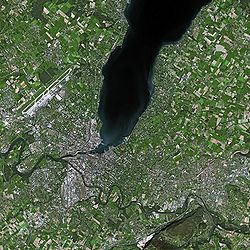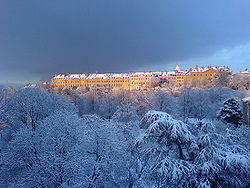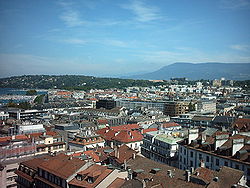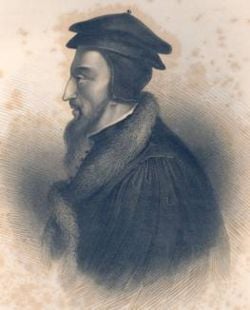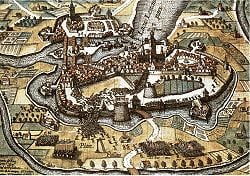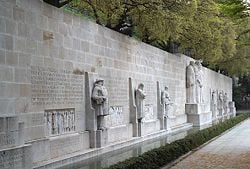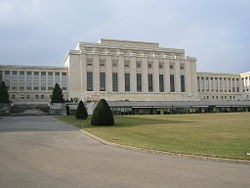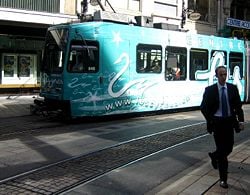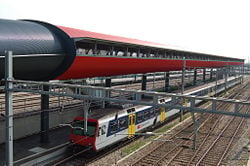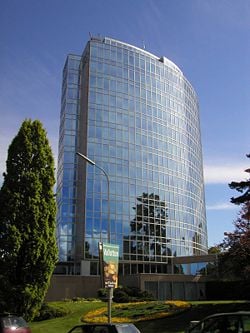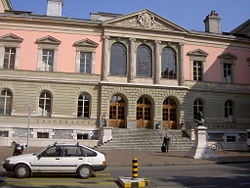Difference between revisions of "Geneva" - New World Encyclopedia
Mike Butler (talk | contribs) |
Mike Butler (talk | contribs) |
||
| Line 96: | Line 96: | ||
Wealth brought culture and artistic creativity in the 18th century. Geneva was the birthplace of [[Jean Jacques Rousseau]] (1712–1778), a home for [[Voltaire]] (1694–1778), and attracted other Enlightenment luminaries. | Wealth brought culture and artistic creativity in the 18th century. Geneva was the birthplace of [[Jean Jacques Rousseau]] (1712–1778), a home for [[Voltaire]] (1694–1778), and attracted other Enlightenment luminaries. | ||
| − | On September 12, 1814, the Genevan republic was admitted to the ranks of the Swiss Confederation. The | + | In 1798, the armies of the [[French Revolution]] conquered Switzerland and imposed a new unified constitution. This centralised the government of the country and effectively abolished the cantons. The new [[regime]], known as the [[Helvetic Republic]], was highly unpopular. |
| + | |||
| + | When war broke out between France and its rivals, Russian and [[Habsburg Monarchy|Austrian]] forces invaded Switzerland. In 1803 [[Napoleon I of France|Napoleon]] organised a meeting of the leading Swiss politicians from both sides in [[Paris]]. The result was the [[Act of Mediation]] which largely restored Swiss autonomy and introduced a Confederation of 19 cantons. | ||
| + | |||
| + | On September 12, 1814, the Genevan republic was admitted to the ranks of the Swiss Confederation. The Second Treaty of Paris, in 1815, ceded 12 Savoy communes. | ||
| + | |||
| + | In 1815 the [[Congress of Vienna]] fully re-established Swiss independence and the European powers agreed to permanently recognise Swiss neutrality. The treaty marked the last time that Switzerland fought in an international conflict. | ||
On October 7, 1846, workers in the suburb of Saint-Gervais revolted against Geneva’s aristocrats, and the conservative government was overthrown. | On October 7, 1846, workers in the suburb of Saint-Gervais revolted against Geneva’s aristocrats, and the conservative government was overthrown. | ||
Revision as of 00:38, 17 November 2008
| Geneva | ||||||||||
|---|---|---|---|---|---|---|---|---|---|---|
| ||||||||||
| Population | 186,825 (2008) | |||||||||
| - Density | Expression error: Unrecognized punctuation character ",". /km² (Expression error: Unrecognized punctuation character ",". /sq.mi.) | |||||||||
| Area | 15.86 km² (6.1 sq mi) | |||||||||
| Elevation | 375 m (1,230 ft) | |||||||||
| A view over Geneva | ||||||||||
| Postal code | 1200 | |||||||||
| SFOS number | 6621 | |||||||||
| Mayor (list) | Patrice Mugny (as of 2008) Vert | |||||||||
| Demonym | Genevois | |||||||||
| Surrounded by (view map) |
Carouge, Chêne-Bougeries, Cologny, Lancy, Grand-Saconnex, Pregny-Chambésy, Vernier, Veyrier | |||||||||
| Website | ville-ge.ch | |||||||||
Geneva (French: Genève) is the second-most populous city in Switzerland (after Zürich) and is the most populous city of Romandie (the French-speaking part of Switzerland).
Geneva is a worldwide center for diplomacy and international cooperation, and is widely regarded as a global city, mainly because of the presence of numerous international organizations, including the headquarters of many of the agencies of the United Nations[1] and the Red Cross.[2] It is also the place where the Geneva Conventions were signed, which chiefly concern the treatment of wartime non-combatants and prisoners of war.
A 2007 survey by Mercer Consulting found Geneva to have the second-highest quality of life in the world (narrowly outranked by Zürich). [3]
Geography
The name Geneva is probably of Celtic origin; the city was mentioned in Latin texts with the spelling Genava. The name takes various forms in modern languages. Thus, it is Geneva in English and pronounced /dʒɨˈniːvə/, French: Genève IPA: [ʒənɛv], Template:Audio-de [gɛnf], Italian: Ginevra [dʒiˈneːvra], and Romansh: Genevra.
Geneva is located at the south-western end of Lake Geneva (French Lac Léman), where the lake flows back into the Rhône River. It is surrounded by two mountain chains, the Alps and the Jura.
The city of Geneva has an area of 15.86 km² (6.1 sq mi), while the area of the Canton of Geneva is 282 km² (108.9 sq mi), including the two small enclaves of Céligny in Vaud. The part of the lake that is attached to Geneva has an area of 38 km² (14.7 sq mi) and is sometimes referred to as Petit lac (English: small lake). The Canton has only a 4.5 km (2.8 mi) long border with the rest of Switzerland; out of a total of 107.5 km (66.8 mi) of borders, the remaining 103 are shared with France, with the Départment de l'Ain to the North and the Département de la Haute-Savoie to the South.
The altitude of Geneva is 373.6 meters (1,225.7 ft), and corresponds to the altitude of the largest of the Pierres du Niton, two large rocks emerging from the lake which date from the last ice age. This rock was chosen by General Guillaume Henri Dufour as the reference point for all surveying in Switzerland.[4]
The climate of Geneva is temperate. Ice storms near the Lac Léman are quite normal in the winter. In the summer many people enjoy swimming in the lake, and frequently patronize public beaches such as Genève Plage and Bains des Pâquis. The average maximum daytime temperature in January of 39°F (4°C), rising to an average maximum of around 77°F (25°C) in July. Mean annual precipitation is 33.5 inches (853mm).
The second main river of Geneva is the Arve River which flows into the Rhône River just west of the city center.
Most of the drinkable water (80 percent) is extracted from the lake; the remaining 20 percent is provided by groundwater originally formed by infiltration from the Arve River.
Thirty percent of the Canton's electricity needs is locally produced, mainly by three hydroelectric dams on the Rhone River (Seujet, Verbois and Chancy-Pougny). In addition, 13 percent of the electricity produced in the Canton is made from the heat induced by the burning of waste at the waste incineration facility of Les Cheneviers.
Natural gas is available in the City of Geneva, as well as in about two-thirds of the municipalities of the canton, and is imported from Western Europe.
Districts
History
Human occupation of the area, which was an easily defended hill dominating the outlet of the lake, began in the Paleolithic Period, and developed into a large community of lake-dwellers who lived in houses built on piles.
Around 500 B.C.E., Geneva was a Celtic fortified settlement. In 58 B.C.E., Geneva was a staging point in the campaign of the Helvetians and the Romans for Gaul. The name Geneva first appears in history as a border town, fortified against the Celto-Germanic Helvetii, which the Romans took in 120 B.C.E.
By 379, Geneva was the seat of a bishop and was within the Roman Empire, although details remain under debate. In 440 St. Salonius appears as Bishop of Geneva.
In 443 C.E., it was taken by Burgundy, and with the latter fell to the Franks in 534. In 888, the town was part of the new Kingdom of Burgundy, and with it was taken over in 1033 by the German Emperor.
In 1387, Bishop Adhémar Fabry granted the town its great charter, the basis of its communal self-government, which every bishop on his accession was expected to confirm.
The city belonged to the Genevese counts until they became extinct in 1394, and the House of Savoy came into possession of their territory. Assuming after 1416 the title of duke, the new Savoy dynasty sought to bring the city of Geneva under their power, particularly by elevating members of their own family to the episcopal see. The city protected itself by union with the Swiss Federation (German: Eidgenossenschaft), uniting itself in 1526 with Berne and Fribourg.
During this struggle, Geneva's burghers secured a contract from the Dukes of Savoy recognizing the public assembly, to which every citizen belonged, as the city's legislative body.
The Protestant Reformation, that began in 1517, plunged Geneva into new entanglements: while Bern favoured the introduction of the new teaching and demanded liberty of preaching for the French evangelists Guillaume Farel (1489–1565) and Antoine Froment (1508-1581), Catholic Fribourg renounced in 1511 its allegiance with Geneva.
In 1532, the Roman Catholic bishop of the city, Pierre de La Baume, was obliged to leave his residence, never to return. The burghers declared the see vacant, and proclaimed themselves a state. Savoy threatened to invade. Geneva needed military support from Protestant Berne. In 1536, the burghers declared the city Protestant.
French theologian and Protestant leader John Calvin (1509–1564), was based in Geneva from 1536 to his death. While expelling all those who would not convert to the Reformed religion, Calvin presided over Geneva's transformed into a modern city-state. Because of presence of the Protestant Bernese troops, Calvin was thus able to reorganize Geneva without intervention by the Roman Catholics from nearby Savoy, whose troop stood outside the city.
Protestant refugees escaped to Geneva from persecution in France. Geneva became a center of Protestant activity, producing works such as the Genevan Psalter, though there were often tensions between Calvin and the city's civil authorities. Though the city proper remained a Protestant stronghold, under bishop St Francis de Sales (1567–1622) a large part of Geneva returned to Catholicism in the early 17th century.
The Roman Catholic Charles Emmanuel I, Duke of Savoy (1562–1630), led a final unsuccessful attempt to recapture Geneva with a surprise attack on the night of December 11–12, 1602.
French and Italian Protestant refugees included noble families who assumed a right to rule. From the mid-16th century, these nobles controlled the aristocratic a Council of Twenty-five, which took over city government while the public assembly rubber-stamped decisions. Opposition to the aristocratic rulers grew among the diminishing numbers of residents who qualified as citizens at the end of the 17th century.
Wealth brought culture and artistic creativity in the 18th century. Geneva was the birthplace of Jean Jacques Rousseau (1712–1778), a home for Voltaire (1694–1778), and attracted other Enlightenment luminaries.
In 1798, the armies of the French Revolution conquered Switzerland and imposed a new unified constitution. This centralised the government of the country and effectively abolished the cantons. The new regime, known as the Helvetic Republic, was highly unpopular.
When war broke out between France and its rivals, Russian and Austrian forces invaded Switzerland. In 1803 Napoleon organised a meeting of the leading Swiss politicians from both sides in Paris. The result was the Act of Mediation which largely restored Swiss autonomy and introduced a Confederation of 19 cantons.
On September 12, 1814, the Genevan republic was admitted to the ranks of the Swiss Confederation. The Second Treaty of Paris, in 1815, ceded 12 Savoy communes.
In 1815 the Congress of Vienna fully re-established Swiss independence and the European powers agreed to permanently recognise Swiss neutrality. The treaty marked the last time that Switzerland fought in an international conflict.
On October 7, 1846, workers in the suburb of Saint-Gervais revolted against Geneva’s aristocrats, and the conservative government was overthrown.
On 30 June 1907, aided by strong Catholic support, Geneva adopted a separation of Church and State. The Protestant faith received a one-time compensatory sum of 800,000 Swiss francs (then about US$160,000), while other faiths received nothing. Since then the Canton of Geneva has given aid to no creed out of either state or municipal revenues.
Government
Switzerland is formally a confederation but similar in structure to a federal republic. The president is both the chief of state and head of government, representing the Federal Council, which is the formal chief of state and head of government, whose council members, rotate in one-year terms as federal president. The bicameral Federal Assembly consists of the Council of States (46 seats) and the National Council (200 seats).
The Swiss Confederation consists of 26 cantons, each of which are responsible for healthcare, welfare, law enforcement, public education, and retain the power of taxation. The cantons comprise a total of 2889 municipalities. Geneva is the capital of the Canton of Geneva, which continues to call itself La Republique du Genève.
The canton is governed by an executive power, the Council of State, which consists of seven members elected for four-year terms, and by a legislature, the Great Council, comprising 100 deputies, also elected for four-year terms by proportional ballot.
The canton is divided into municipalities (or communes) which have their own assemblies and a mayor, a (Stadtpräsident), who is a first among equals in the executive council.
The city of Geneva is divided into eight "quartiers" or districts, often made up of several conglomerated neighborhoods.[5] On the Left Bank (Rive Gauche) these include Jonction, Centre / Plainpalais / Acacias, Eaux-Vives and Champel while the Right Bank includes Saint-Jean / Charmilles, Servette / Petit-Saconnex, Grottes / Saint-Gervais and Paquis / Nations.
Geneva is the seat of the European headquarters of the United Nations and of many other inter-governmental organizations.
Geneva was the seat of the League of Nations between 1919 and the league's dissolution in 1946. It was first housed in the Palais Wilson, and then in the Palais des Nations, which now hosts the United Nations. Numerous international non-governmental organizations have also elected Geneva as their headquarters.
Economy
Switzerland is a peaceful, prosperous, and stable modern market economy with low unemployment, a highly skilled labor force, and a per capita GDP ($40,100 in 2007) larger than that of the big Western European economies.
Geneva's economy is mainly services oriented. The city has an important and old finance sector, which is specialized in private banking (managing assets of about 1 trillion USD) and financing of international trade. It is also an important centre of commodity trade.
Many people work in the numerous offices of international organizations located in Geneva (about 24,000 in 2001). Geneva hosts the international headquarters of companies like JT International (JTI), Mediterranean Shipping Company, Serono, SITA, Société Générale de Surveillance and STMicroelectronics. Many other multinational companies like Caterpillar, DuPont, Take Two Interactive, Electronic Arts, Hewlett-Packard, INVISTA, Procter & Gamble and Sun Microsystems have their European headquarters in the city too.
There is a long tradition of watchmaking (Baume et Mercier, Chopard, Franck Muller, Patek Philippe, Rolex, Raymond Weil, Omega, etc.). Two major international producers of flavours and fragrances, Firmenich and Givaudan, have their headquarters and main production facilities in Geneva.
The city's main newspaper is the Tribune de Genève, with a readership of about 187,000, a daily newspaper founded in 1879. Le Courrier, founded in 1868, was originally supported by the Roman Catholic Church, but has been completely independent since 1996.
Geneva is covered by the various French language radio networks of the Swiss Broadcasting Corporation, in particular the Radio Suisse Romande.
The main television channel covering Geneva is the Télévision Suisse Romande; while its headquarters are located in Geneva, the programs cover the whole of Romandy and are not specific to Geneva.
The Geneva Motor Show is one of the most important international auto-shows. The show is held at Palexpo, a giant convention center located next to the International Airport
Geneva is connected to both the Swiss railway network SBB-CFF-FFS, and the French SNCF network, including direct connections to Paris, Marseille and Montpellier by TGV. Geneva is also connected to the motorway systems of both Switzerland (A1 motorway) and France. Public transport is by bus, trolleybus, tram, or by boat, which link the two banks of the lake within the city. Taxis in Geneva can be difficult to find, and often refuse to take babies and children. The city is served by the Geneva Cointrin International Airport.
Demographics
As of June 2008, the population of the Commune (city) of Geneva was 186,825.[6] The city of Geneva is at the center of the Geneva metropolitan area, known as the agglomération franco-valdo-genevoise in French. The agglomération franco-valdo-genevoise includes the Canton of Geneva in its entirety as well as the District of Nyon in the Canton of Vaud and several areas in the neighboring French departments of Haute-Savoie and Ain. In 2005 the agglomération franco-valdo-genevoise had 769,000 inhabitants, two-third of whom lived on Swiss soil and one-third on French soil.[7] The Geneva metropolitan area is experiencing steady demographic growth of 1.2 percent a year and the agglomération franco-valdo-genevoise is expected to reach one million people in 2030.[7]
The population of the Canton contains 148,500 people originally from Geneva (33.7 percent), 122,400 Swiss from other cantons (27.6 percent) and 170,500 foreigners (38.7 percent), from 180 different countries.[8] Including people holding multiple citizenship, 54.4 percent of people living in Geneva hold a foreign passport.[9]
The ethnic make-up of Switzerland is: German 65 percent, French 18 percent, Italian 10 percent, Romansch 1 percent, other six percent.
Geneva is remarkable for its linguistic diversity, the result of the presence of the United Nations and over 150 international organisations, the headquarters of some 140 multi-national companies, 120 diplomatic missions, and a centuries of trade. Geneva has a 40 percent non-Swiss resident population with English the language of communication. Language Franco-Provençal language German, which is spoken by 63.7 percent of the Swiss population, French 20.4 percent, and Italian 6.5 percent, are all official languages.
While Geneva is usually considered a Protestant city, there are now more Roman Catholics (39.5 percent) than Protestants (17.4 percent) living in the Canton. About 22 percent of the inhabitants claim no religion, and the remainer practice Islam (4.4 percent), Judaism (1.1 percent), other religions, or did not respond.[10]
Geneva is home to the University of Geneva, founded by John Calvin in 1559. Also, the oldest international school in the world is located in Geneva, the International School of Geneva, founded in 1924 along with the League of Nations. Webster University, an accredited American university also has a campus in Geneva.
The Geneva School of Diplomacy and International Relations is a private university on the grounds of the Château de Penthes, an old manor with a park and view of Lac Leman.
However, out of all the educational and research facilities in Geneva, CERN is probably the best known on a world basis. Founded in 1954, CERN (the European Organization for Nuclear Research) was one of Europe's first joint ventures and has developed as the world's largest particle physics laboratory. Physicists from around the world travel to CERN to research matter and explore the fundamental forces and materials that form the world.
Of interest
Geneva observes Jeune genevois on the first Thursday following the first Sunday in September. By local tradition, this commemorates the date the news of the St. Bartholomew's Day massacre of Huguenots reached Geneva. The Genevois joke that the federal equivalent holiday, Jeune fédéral, is observed two weeks later on account of the rest of the country being a bit slow on the uptake.
Since 1818, a particular chestnut tree has been used as the official "herald of the spring" in Geneva. The sautier (secretary of the Parliament of the Canton of Geneva) observes the tree and notes the day of arrival of the first bud. While this event has no practical impact, the sautier issues a formal press release and the local newspaper will usually mention the news.
As this is one of the world's oldest records of a plant's reaction to climatic conditions, researchers have been interested to note that the first bud appears earlier and earlier in the year. During the first century, many dates were in March or April. In recent years, it has usually been in mid-February and sometimes even earlier.[11] In 2002, the first bud appeared unusually early, on 7 February, and then again on 29th of December of the same year. The following year, one of the hottest Europe has ever had, became a year with no bud. In 2008, the first bud also appeared very early, on 19 February.
The main sport team in Geneva is Servette FC, a football club founded in 1890 and named after a borough on the right bank of the Rhône. Servette was the only club to have remained in the top league in Switzerland since its creation in the 1930s; in 2005, however, management problems resulted in the bankruptcy of the club's parent company, causing the club to be demoted two divisions. It is now playing in second division.
Geneva is also home of the Genève-Servette Hockey Club, who play in the Swiss National League A. In 2008 the team made it to the league finals but lost to the ZSC Lions.
Looking to the future
ReferencesISBN links support NWE through referral fees
- ↑ Staying on the Safe Side; Geneva. The New York Times. The New York Times Company (1990-06-24). Retrieved 2008-04-19.
- ↑ 36 Hours in Geneva. The New York Times. The New York Times Company (2007-09-16). Retrieved 2008-02-02.
- ↑ Mercer Human Resource Consulting World-wide quality of living survey. London, 2 April 2007. Last accessed 13 January 2008
- ↑ Swisstopo, Height reference for Switzerland. Last accessed on 1 February 2007.
- ↑ Districts of Geneva. Official Website of Geneva. Retrieved 2008-02-09.
- ↑ Cite error: Invalid
<ref>tag; no text was provided for refs namedcity - ↑ 7.0 7.1 Cite error: Invalid
<ref>tag; no text was provided for refs namedmetro_area - ↑ Population of Geneva, on the website of Statistique Genève. Last accessed 1 February 2007.
- ↑ OCSTAT. Les binationaux dans le canton de Genève. Résultats du recensement fédéral de la population 2000. Communications statistiques n° 24, Geneva, December 2005.
- ↑ Inhabitants of the Canton of Geneva according to their religion, on the website of Statistique Genève. Last accessed 1 February 2007.
- ↑ La Une de la FAO no 93 année 253 : FAO: La Treille, promenade et lieu d'observation climatique
Further reading
- Geneva (municipality) in German, French or Italian in the online Historical Dictionary of Switzerland.
- Jean de Senarclens, "Geneva: Historic Guide", Editions du Tricorne, 1995. ISBN 2-8293-0144-7
External links
- Encyclopaedia Britannica Geneva Retrieved November 14, 2008.
- World Fact Book 2008 Switzerland Retrieved November 14, 2008.
- Geneva Retrieved November 14, 2008.
- Official
- Geneva - Welcome to Networld
- Official website of the City of Geneva
- Official website of the Canton of Geneva (French)
- The official Chestnut Tree, on the website of the Canton of Geneva (French)
- Geneva Palexpo, exhibitions and congresses center, owned by the State of Geneva.
- International Geneva Motor-Show.
- Pictures from Motor-Show 2008
- Tourism
- Geneva Tourism
- Geneva public transport
- International Geneva Welcome Centre
- Brief history of Geneva
- Travel guide to Geneva from Wikitravel
- Geneva information
- Some pictures
- Study
- Other
Credits
New World Encyclopedia writers and editors rewrote and completed the Wikipedia article in accordance with New World Encyclopedia standards. This article abides by terms of the Creative Commons CC-by-sa 3.0 License (CC-by-sa), which may be used and disseminated with proper attribution. Credit is due under the terms of this license that can reference both the New World Encyclopedia contributors and the selfless volunteer contributors of the Wikimedia Foundation. To cite this article click here for a list of acceptable citing formats.The history of earlier contributions by wikipedians is accessible to researchers here:
The history of this article since it was imported to New World Encyclopedia:
Note: Some restrictions may apply to use of individual images which are separately licensed.

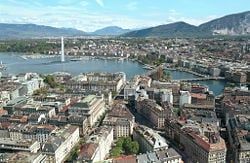
![Geneva [zoom] (Switzerland)](/d/images/thumb/c/cf/Karte_Schweiz.png/265px-Karte_Schweiz.png)
